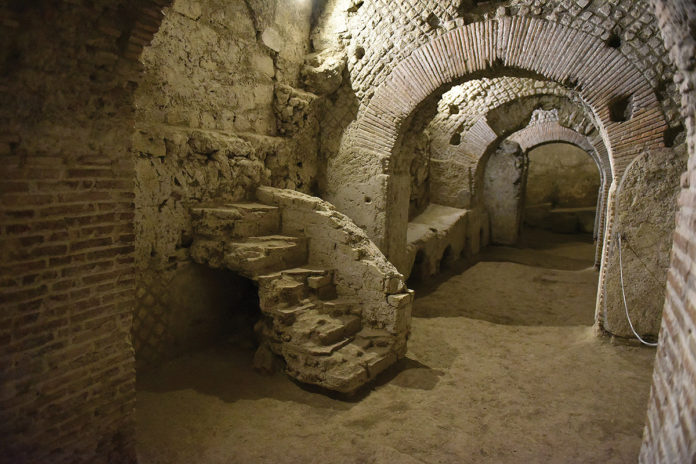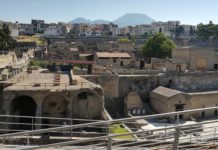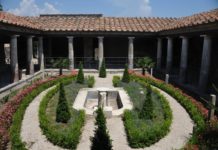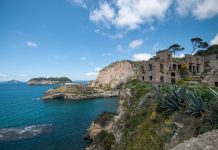
“The Dna of Naples is to be found here” said Master Riccardo Muti, In rhe “pretty and beautiful temple” as Boccaccio called it, the famous poet met Fiammetta, and always here Petrarch lived for a while. Three superimposed periods, joined into a unique, precious casket, to be discovered from top to bottom.
Painters, architects, sculptors and archaeologists have written wonderful pages on the basilica of San Lorenzo Maggiore in Naples. It is here, in the heart of the city of Naples, that the two souls of the city of Virgil and St. Gennaro join together, creating an amalgam of rare beauty. “It’s a monument to books. In the complex of San Lorenzo Maggiore one can read the history of Naples in clear letters. The Dna of Naples is to be found here” said Master Riccardo Muti, before a concert. This phrase perfectly describes the “pretty and beautiful temple” as Boccaccio called it. The famous poet met Fiammetta, his inspiring muse, for the first time in this church in 1334 and always here, a few years later, Petrarch lived for a while.
The monumental complex of Piazza San Gaetano, which attracts thousands of visitors each year and hosts important events, represents a kind of “trait d’union”, a rare example of the continuity of life, which testimonies the plurisecular life of Naples. Above, stands the thirteenth-century church founded by Carlo d’Angiò. At the bottom, lies what remains of an ancient Greek-Roman settlement. At the centre, as a symbolic “watershed”, are the ruins of a building dating back to the Norman domination. Three superimposed periods, joined into a unique, precious casket, to be discovered from top to bottom.
Near the eighteenth-century cloister of the basilica, is it possible to admire the ruins of the ancient Roman Macellum in the archaeological site of San Lorenzo Maggiore. The structure was arranged on terraces and has, in its center, a circular colonnade (tholos).
Through a modern staircase, it is possible to directly access the archaeologal site of San Lorenzo Maggiore, “The Buried Naples” from the cloister of the church. Here, at 7.8 meters underground, there is the ancient Forum of Neapolis and an old market which dates back to the 4th century BC. Other stratifications of the imperial age are to be found there.
The route runs along a narrow street (cardine), over which there are nine shops, each with two rooms. Originally, they may have hosted public offices, including the Aerarium, where the city treasury was guarded. Following the decay of the Empire, they became small workshops such as bakeries and laundries.
At the end of the narrow street, on the right, there is an open cryptoportic (the covered market): the area is divided into small buildings. These are shops with masonry desks that were used for displaying the merchandise on sale. The final part of the “porch” is linked to a large vaulted environment where there is a late-Hellenistic hydraulic structure: it was used to channel the flow of rainwater. A little further away, immediately next to a tub, there is another complex: three large interconnecting rooms, with a mosaic floor and an impluvium in the central part of the house. It may have been a schola, which was, a building intended for meetings of religious or commercial associations. In this area there are also some wall remakes of the late antique medieval period.
The archaeological site of San Lorenzo Maggiore in Naples was brought to light with a vast excavation campaign that began in the late seventies of the last century. Interrupted several times, the campaign was finally concluded in May 2009, thanks to the funding of the European Union. Many of the objects and finds recovered during the excavations are now on show in the adjacent Opera Museum, hosted in the bell tower of the Basilica, which is worth a visit.
(translate by Teresa Freddo)
INFO FOR THE ARCHAELOGICAL SITE OF SAN LORENZO MAGGIORE – THE BURIED NEAPOLIS
Monumental complex of San Lorenzo Maggiore in Naples
Piazza San Gaetano, 316 – 80134 Naples.
EXCAVATION TICKETS: Ordinary: € 9,00 – € 7,00 Artecard, teachers, university students and over 65 – € 6,00 under 18 – € 4 school groups.
OPENING TIMES: every day 9:30 – 17:30.
INFO: Tel. 081.211.08.60 – 389.540.40.71
www.laneapolissotterrata.it
www.sanlorenzomaggiorenapoli.i

 Italiano
Italiano













